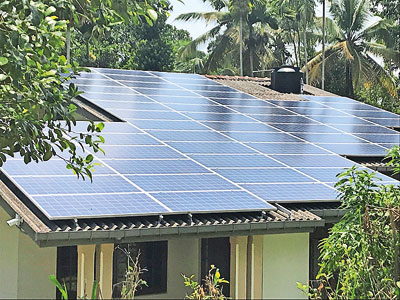Sunday Times 2
Solar roof performance in Sri Lanka and benefits to society

The 20 kW solar roof installed at Kumburegama village, Kandy in Sri Lanka.
In the era of solar revolution, solar roofs are mushrooming round the globe. In Sri Lanka also, solar roofs are becoming popular and the aim of this article is to provide data to help Sri Lankans to understand the value of these projects. This in turn will accelerate the take-up of solar roofs in the country. For this article, we have selected a large solar roof plant of 20 kW.
The solar roof selected for this article is from Kandy area. The photograph is shown below, and the technical details of the system are given in the table.
Performance of the solar roof
This system was installed under the Government’s “Net Plus” scheme. The performance of the solar roof during a day is given below. There are two charts to show the performance during a sunny day and a rainy/cloudy day. The system produces electricity from 7 am to 4 pm during the day and the total electricity produced is fed to the national grid. On a sunny day, the system produces 94.5 kWh (units), and a rainy/cloudy day produces 65.3 kWh. The performance during a month is given by the following charts. Again, the data for a typical good month and a monsoon month are shown for comparison. A good month (March) produces 2,744 units and a monsoon month (November) produces 1,773 units.
The total electricity production and export to the national grid in 2019 is given by the chart. The average production per month is 1,965 units and the total for the whole year is 23,582 units.
Income and pay-back period
The grid connection agreement according to the “Net Plus” scheme is for 20 years. The Ceylon Electricity Board (CEB) will pay Rs 22 per kWh for the first 7 years, and Rs 15 per kWh for the remaining 13 years. Solar panels can work up to 30 years, and after 20 years the system could be used according to the rules and regulations during that time.
Total generation per annum during the first 7 years = 23,582 kWh
The total income per annum during the first 7 years = 23,582 x 22 = Rs 518,804
Total cost of the system = Rs 2,600,000
Therefore, the simple payback period = 5.01 years.
The total income per annum after first 7 years = Rs 23,582 x 15 = Rs 353,730
The owner will receive an income of ~Rs 5.18 lakhs per annum for two more years and ~Rs 3.53 Lakhs per annum for the next 13 years.
There will be slight changes to these figures due to ageing of the system, but these figures show the financial benefits to the owner of this system. By the end of 20 years contract, by spending Rs 26 Lakhs, the owner will receive Rs 82.3 Lakhs as the total return. These solar panels have a lifetime of ~30 years and the owner will enjoy free electricity for another 10 years, provided the system continues after 20 years, to use at home plus export the surplus to the grid receiving continuous income, during retirement.
 Other benefits of the system
Other benefits of the system
The above figures indicate the financial benefits to the owner of the solar roof. In addition to these personal benefits, the owner contributes to many other social benefits.
This system provides significant carbon offset showing about 62 tons a year. This reduces emission of carbon dioxide and other polluting gas and particles to the atmosphere.
The system itself acts as a promotional system to encourage people to produce clean energy, instead of the country producing energy by burning imported, expensive, and polluting coal, liquid, and gaseous fossil fuels.
In the future, most of the cars will be electric, and the owner will benefit by having enough solar energy to charge the car free at home. Policies have already been announced in the UK, prohibiting manufacture of cars based on combustion engines, after 2030.
(Sarath Wijesinghe is a Senior Power System and Grid Integration Engineer RWE Renewables UK (Sarath.wijesinghe@rwe.com). I. M. Dharmadasa is a professor, solar energy researcher, and promoter of clean energy applications at Sheffield Hallam University in the UK (Dharme@shu.ac.uk)


